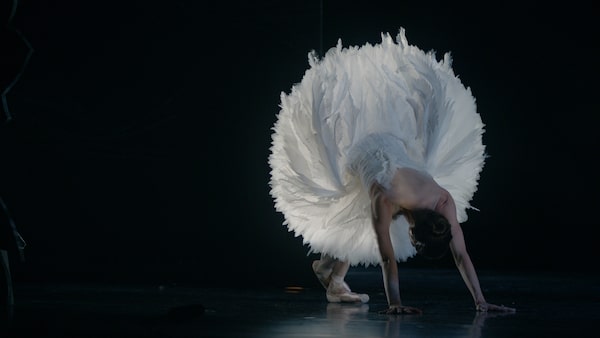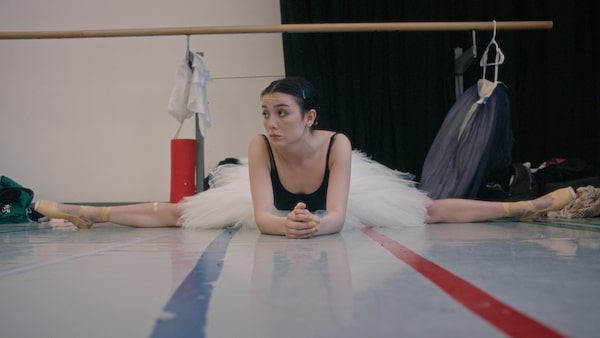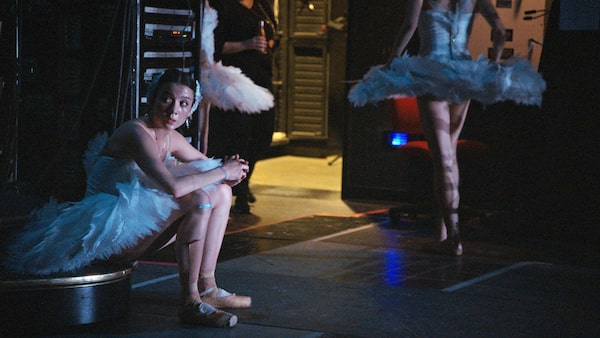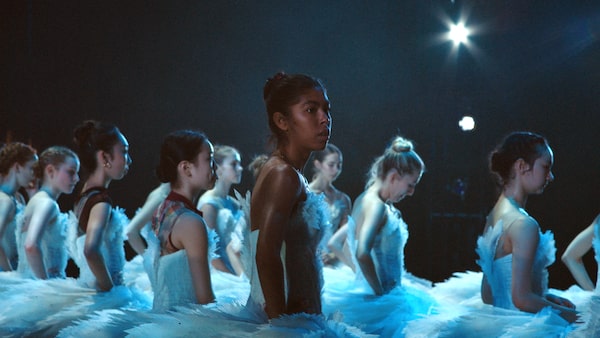
Chelsea McMullan takes us inside the National Ballet of Canada’s 2022 production of Swan Lake, directed and staged by the legendary Karen Kain.TIFF
The pitch wrote itself: Karen Kain, icon, was capping her 50-year career with the National Ballet of Canada by directing her very first production. Of Swan Lake, the most revered ballet in the classical canon. The one that had transformed 19-year-old novice Kain into an international sensation. But updated with radical revisions for a new generation of dancers. Director Chelsea McMullan and writer/producer Sean O’Neill, who specialize in documentaries about the artistic process (the film Ever Deadly, the CBC series In the Making) would film it all, from the viewpoints of fascinating characters from different levels of ballet’s hierarchy. They had the perfect title: Swan Song. Plus, there was a ticking clock, eight weeks from the first day of rehearsals until opening night.
McMullan and O’Neill’s ambitions were as lofty as Kain’s: old-school, verité-style filmmaking, which is both expensive and time-consuming. Two cameras, five days a week, 10 hours a day; and then nine cameras on opening night, including one that swung through the air on a cable. The actress Neve Campbell (Scream), who attended the National Ballet School from age 9 to 14, signed on as a producer. “I saw Karen Kain do Swan Lake when I was 10,” Campbell said in a phone interview. “I remember it vividly still. It was like watching a miracle.”
CBC commissioned a four-part series. Dogwoof, a U.K.-based production and sales company, offered financing, but only if McMullan (who uses they/them pronouns) also cut a film version. They preinterviewed 60 members of the company, finessed permission from five unions, and began the delicate process of gaining the trust of artists who’d never been tracked by cameras, in a culture allergic to exposure.
Karen Kain’s Swan Lake is a fitting final act for Canada’s most famous ballerina
On day one of rehearsals, McMullan stood in a corner of a ballet studio, armed with a smartphone, which served as their monitor for both film cameras; a walkie, so they could steer their camerapeople toward the right moments; a headset, to flip through seven channels of audio from the subjects’ mics; a notebook, for scribbling thoughts on the fly; and zero idea of the tumult about to ensue.
Not only were the dancers learning new choreography, the crew were learning about ballet and how to film it. “There was this infinity mirror between their process and ours,” O’Neill said in a joint video interview with McMullan. “It was a mutual exchange of vulnerability.”

Bryant’s crew shared insights into the value of repetition: how filming basketball practices over and over transported the filmmakers deep into the language and process of the game.Supplied
One early challenge: How to mic dancers who wear whisper-thin leotards and tights, when anything on their bodies can affect their movement? McMullan found the answer in an unexpected place: the U.S. National Basketball Association.
Back in 2017, NBA star Kobe Bryant invited McMullan to Los Angeles. His nascent production company had spent a year filming every practice and game of his final NBA season, and he wanted McMullan’s artist’s eye on the rushes. McMullan was fascinated by all of it – including the tiny mics Bryant used, battery packs the size of a credit card, developed for players to wear during games. They brought the mics to Swan Song; after a few days the dancers were running to the sound team, arms up, to be wired.
Bryant’s crew also shared insights into the value of repetition: how filming basketball practices over and over transported the filmmakers deep into the language and process of the game. Gradually, the same happened with McMullan’s crew. They internalized the choreography, moving instinctually toward key moments. They understood the athleticism – in act four alone, the corps de ballet runs the equivalent of a 5K – capturing remarkable scenes of the dancers recovering in ice baths and enduring nerve-numbing needles without flinching.
“Dance has two sides,” Campbell says. “What you see on stage is grace, beauty, light. What it takes to get there is excruciating. I loved being a dancer, but I had to have spine surgery, foot surgery. I was doing physio from age 9. Dancers are fighters.”
Another challenge: getting Kain, the preternaturally poised, lifelong protector of her ballet company, to open up. She readily talked about her concept of Swan Lake. She saw the villain, Rothbart, as a narcissistic kidnapper. His victims weren’t birds, but real women, with feelings and souls. “I wanted it rooted in something that happens in the world,” Kain said in a separate video interview. “To make it real for me, not just a silly fairy tale.”
Perhaps most radically, she jettisoned traditional pink tights and presented her dancers bare-legged. She knew that would open the documentary to discussions about racism in ballet, and about dancers’ body image, and she was ready. “Pink tights seem so old-fashioned,” Kain says. “We should be moving on, appreciating all the beautiful skin colours we have in the National Ballet of Canada.”

Kain never raises her voice, but her silences can be terrifying.TIFF
The more the film crew learned about ballet, however, the more they realized that Kain’s dancers were struggling – with the speed of Kain’s version, which compresses four acts into two; with Gabriela Tylesova’s fantastical costumes, gorgeous but unwieldly; and with the spectre of the nine previous versions of Swan Lake that principle ballerina Jurgita Dronina had already danced.
“Nothing was going well!” McMullan recalls. “Sean and I were terrified: ‘We’re filming Karen Kain’s production as a nosedive bonfire!’ ”
“You see this woman we all adore, who some call the Princess Diana of Canada,” Campbell says. “You see how respected she is, what a talent she is. And you also see her in moments where she’s just an artist at a loss. No matter what level an artist gets to, you have moments of feeling like you don’t know what you’re doing, and you have to go through the creative process to find it. Even Karen Kain.”
Kain never raises her voice, but her silences can be terrifying. “When I danced, I was tough to my partners if I didn’t feel they were giving their full attention, or weren’t in their best physical shape,” she says. “These things are really important to me, and always have been. My mentor was Rudolph Nureyev, who worked even harder than I did. I never saw him have a lazy moment, ever.
“I got pleasure out of working that hard and caring that much.” Delicate pause. “Not everybody is like that.”
That theme – what’s “worth it” in an artistic endeavor, versus what’s “too much” – echoes between Swan Lake and Swan Song. The dancers’ nerves frayed as their bodies teetered on the edge of injury. The camera operators lost 25 pounds each as they sprinted alongside their subjects. The story editors worked overtime to log 450 hours of footage, using both a system McMullan learned from the lauded documentary director Frederick Wiseman (grade every scene one to three stars) and one that story editor Victoria Abolarinde learned on the reality series Big Brother (mark moments with hashtags, such as #pain, #tension or #KarenVision). Then, after toiling four solid months on an edit, McMullen and O’Neill tearfully admitted it wasn’t working. They threw it out and started from scratch.
Yet both projects miraculously came together. On Swan Lake’s opening night, the ballerinas clicked into place like a Rubik’s Cube. Backstage afterward, their surprise and euphoria are palpable. And Swan Song is a raw, gorgeous, provocative, enlightening work of art. It will premiere at the Toronto International Film Festival on Sept. 9, open in Canadian theatres Sept. 29, and have its international premiere at the BFI London Film Festival in October. The four-part series arrives on CBC and CBC Gem Nov. 22.

The theme – what’s 'worth it' in an artistic endeavor, versus what’s 'too much' – echoes between Swan Lake and Swan Song.TIFF
“We feel such deep relief that it worked out,” O’Neill says. “But ‘worth it’ versus ‘too much’ is the eternal question in making anything that’s ambitious and hard. You can never answer how far is too far.”
A moment near Swan Song’s end, captured on those NBA mics, comes close. As the audience rises to its feet, two dancers, chests still heaving from exertion, whisper to one another, “Nobody understands. I love you. Nobody understands.”
Special to The Globe and Mail